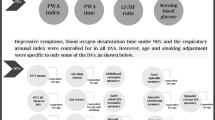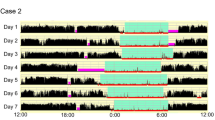Abstract
Objective
Obstructive sleep apnea (OSA), a sleep disorder, results in decreased daytime alertness and neurocognitive dysfunction. Obesity is considered a major risk factor for the development and progression of OSA and the resulting cognitive dysfunction. However, the effect of obesity on neurocognitive dysfunction in OSA has been rarely investigated.
Methods
Eighty-three patients with moderate to severe OSA syndrome were recruited in our study. After matching for education, age, and body mass index (BMI), 40 patients were enrolled into our study with matched obese (BMI ≧ 30) and non-obese (BMI < 30) groups. All enrolled patients completed a polysomnographic study, sleepiness questionnaires, and attention, cognitive, and memory function tests.
Results
Compared to obese OSA patients, non-obese OSA patients had shorter reaction times in the psychomotor vigilance task but not the Flanker or Stroop cognitive tasks. Additionally, obese OSA patients had a reduced capacity for working memory relative to non-obese OSA patients.
Conclusions
Obesity had a significant effect on OSA patients in our study, including delayed reaction times in the psychomotor vigilance task and a decrease in working memory.
This is a preview of subscription content, access via your institution
Access options
Subscribe to this journal
Receive 12 print issues and online access
$259.00 per year
only $21.58 per issue
Buy this article
- Purchase on Springer Link
- Instant access to full article PDF
Prices may be subject to local taxes which are calculated during checkout
Similar content being viewed by others
References
Young T, Palta M, Dempsey J, Skatrud J, Weber S, Badr S. The occurrence of sleep-disordered breathing among middle-aged adults. N Engl J Med. 1993;328:1230–5.
The American Academy of Sleep Medicine Task Force. Sleep-related breathing disorders in adults: recommendations for syndrome definition, measurement techniques in clinical research. Sleep. 1999;22:667–89.
Lal C, Strange C, Bachman D. Neurocognitive impairment in obstructive sleep apnea. Chest. 2012;141:1601–10.
Verstraeten E, Cluydts R, Pevernagie D, Hoffman G. Executive function in sleep apnea: controlling for attentional capacity in assessing executive attention. Sleep. 2004;27:685–93.
Twigg GL, Papaioannou I, Jackson M, Ghiassi R, Shaikh Z, Jaye J, et al. Obstructive sleep apnea syndrome is associated with deficits in verbal but not visual memory. Am J Respir Crit Care Med. 2010;182:98–103.
Jackson ML, Howard MD, Barnes M. Cognition and daytime functioning in sleep-related breathing disorders. Prog Brain Res. 2011;190:53–68.
Salorio CF, White DA, Piccirillo J, Duntley SP, Uhles ML. Learning, memory, and executive control in individuals with obstructive sleep apnea syndrome. J Clin Exp Neuropsychol. 2002;24:93–100.
Chang ET, Shiao GM. Craniofacial abnormalities in Chinese patients with obstructive and positional sleep apnea. Sleep Med. 2008;9:403–10.
Smith E, Hay R, Campbell L, Trollor JN. A review of the association between obesity and cognitive function across the lifespan: implications for novel approaches to prevention and treatment. Obes Rev. 2011;12:740–55.
Wang J, Chen R, Peng WD, Zhang YL, Shen JC, Li J, et al. Association between obesity and cognition impairment in patients with moderate-to-severe obstructive sleep apnea-hypopnea syndrome. Zhonghua Yi Xue Za Zhi. 2013;93:3817–21.
Coppin G, Nolan-Poupart S, Jones-Gotman M, Small DM. Working memory and reward association learning impairments in obesity. Neuropsychologia. 2014;65:146–55.
Johns MW. A new method for measuring daytime sleepiness: the Epworth sleepiness scale. Sleep. 1991;14:540–5.
Buysse DJ, Reynolds CF, Monk TH, Berman SR, Kupfer DJ. The Pittsburgh Sleep Quality Index (PSQI): a new instrument for psychiatric research and practice. Psychiatry Res. 1989;28:193–213.
Gur RC, Ragland JD, Moberg PJ, Turner TH, Bilker WB, Kohler C, et al. Computerized Neurocognitive Scanning: I. Methodology and Validation in Healthy People. Neuropsychopharmacology. 2001;25:766–76.
Dinges DF, Powell JW. Microcomputer analyses of performance on a portable, simple visual RT task during sustained operations. Behav Res Methods Instrum Comput. 1985;17:652–5.
Batool-Anwar S, Kales SN, Patel SR, Varvariqou V, DeYoung PN, Malhotra A. Obstructive sleep apnea and psychomotor vigilance task performance. Nat Sci Sleep. 2014;6:65–71.
Chou SP, Hsu CY, Wu MN, Liou LM, Lu SR, Liu CK, et al. Action-Monitoring Dysfunction in Obstructive Sleep Apnea-A Pilot Study. PLoS ONE. 2016;11:e0157575.
Eriksen BA, Eriksen CW. Effects of noise letters upon identification of a target letter in a non-search task. Percept Psychophys. 1974;16:143–9.
Macleod CM. Half a century of research on the Stroop effect: an integrative review. Psychol Bull. 1991;109:163–203.
Macleod CM, McDonald PA. Interdimensional interference in the Stroop effect: uncovering the cognitive and neural anatomy of attention. Trends Cogn Sci. 2000;10:383–91.
Tulek B, Atalay NB, Kanat F, Suerdem M. Attentional control is partially impaired in obstructive sleep apnea syndrome. J Sleep Res. 2013;22:422–9.
Elias MF, Elias PK, Sullivan LM, Wolf PA, D’Agostino RB. Lower cognitive function in the presence of obesity and hypertension: the Framingham heart study. Int J Obes Relat Metab Disord. 2003;27:260–8.
Gunstad J, Lhotsky A, Wendell C, Ferrucci L, Zonderman A. Longitudinal examination of obesity and cognitive function: results from the Baltimore longitudinal study of aging. Neuroepidemiology. 2010;34:222–9.
Pugh KG, Lipsitz LA. The microvascular frontal-subcortical syndrome of aging. Neurobiol Aging. 2002;23:421–31.
Miller, BL The human frontal lobes: An introduction. In: Miller, BL; Cummings, JL, editors. The Human Frontal Lobes: Functions and Disorders. (Guilford press; New York, NY, 2007) pp 3–12.
Xanthopoulos MS, Gallagher PR, Berkowitz RI, Redcliffe J, Bradford R, Marcus CL. Neurobehavioral functioning in adolescents with and without obesity and obstructive Sleep Apnea. Sleep. 2015;38:401–10.
Thomann J, Baumann CR, Landolt HP, Werth E. Psychomotor vigilance task demonstrates impaired vigilance in disorders with excessive daytime sleepiness. J Clin Sleep Med. 2014;10:1019–24.
Aloia MS, Arnedt JT, Davis JD, Riggs RL, Byrd D. Neuropsychological sequelae of obstructive sleep apnea-hypopnea syndrome: a critical review. J Int Neuropsychol Soc. 2004;10:772–85.
Kylstra WA, Aaronson JA, Hofman WF, Schmand BA. Neuropsychological function after CPAP treatment in obstructive sleep apnea: a meta-analysis. Sleep Med Rev. 2013;17:341–47.
Li TH, Shen YC, Wang HM, Chang ET, Jan HT. Improvements in cognitive function after continuous positive airway pressure treatment for obstructive sleep apnea syndrome. Neuropsychiatry. 2017;7:781–7.
Hilsendager CA, Zhang D, McRae C, et al. Assessing the influence of obesity on longitudinal executive functioning performance in patients with obstructive sleep apnea syndrome. Obes Res Clin Pract. 2016;10:33–40.
Acknowledgements
Funding
Buddhist Tzu Chi General Hospital provided financial support in the form of funding for design and data acquisition. The sponsor had no role in the design or conduct of this research.
Author information
Authors and Affiliations
Corresponding author
Ethics declarations
Conflict of interest
All authors certify that they have no affiliations with or involvement in any organization or entity with any financial interest (such as honoraria; educational grants; participation in speakers’ bureaus; membership, employment, consultancies, stock ownership or other equity interest; and expert testimony or patent-licensing arrangements) or non-financial interest (such as personal or professional relationships, affiliations, knowledge or beliefs) in the subject matter or materials discussed in this manuscript.
Ethical approval
All procedures performed in studies involving human participants were in accordance with the ethical standards of the institutional and/or national research committee and with the 1964 Helsinki Declaration and its later amendments or comparable ethical standards.
Informed consent
Informed consent was obtained from all individual participants included in the study.
Rights and permissions
About this article
Cite this article
Shen, YC., Kung, SC., Chang, ET. et al. The impact of obesity in cognitive and memory dysfunction in obstructive sleep apnea syndrome. Int J Obes 43, 355–361 (2019). https://doi.org/10.1038/s41366-018-0138-6
Received:
Revised:
Accepted:
Published:
Issue Date:
DOI: https://doi.org/10.1038/s41366-018-0138-6
This article is cited by
-
Effect of preoperative sleep disorders on delirium in proximal femoral surgery patients aged 60 or older
BMC Anesthesiology (2023)
-
Impaired psychomotor vigilance associated with sleep-disordered breathing in women working in the care of older adults in Japan
Sleep and Breathing (2022)
-
Screening for mild cognitive impairment in people with obesity: a systematic review
BMC Endocrine Disorders (2021)
-
Effects of Obstructive Sleep Apnea and CPAP on Cognitive Function
Current Neurology and Neuroscience Reports (2021)
-
The relationship between inflammation and neurocognitive dysfunction in obstructive sleep apnea syndrome
Journal of Neuroinflammation (2020)



